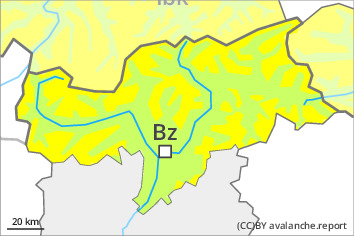
Danger level
 | 2000m |
|  |
|  | ||||
|  |
|  |

Weak layers in the old snowpack necessitate caution, especially on steep shady slopes at high altitudes and in high Alpine regions. Fresh wind slabs require caution.
Weak layers in the old snowpack can be released in some places by individual winter sport participants. The avalanche prone locations are to be found in particular on very steep shady slopes above approximately 2000 m. Caution is to be exercised in gullies and bowls, and behind abrupt changes in the terrain, as well as adjacent to ridgelines. Mostly avalanches are small. On wind-loaded slopes medium-sized avalanches are possible.
As a consequence of new snow and a moderate to strong wind, sometimes avalanche prone wind slabs will form in particular adjacent to ridgelines and in pass areas as well as at high altitudes and in high Alpine regions.
Individual gliding avalanches can also occur, in particular in the south.
At elevated altitudes and in the south the avalanche prone locations are more prevalent and the danger is slightly greater.
Snowpack
dp.1: deep persistent weak layer
dp.6: cold, loose snow and wind
Avalanche prone weak layers exist in the old snowpack, especially on steep shady slopes above approximately 2000 m, as well as on steep sunny slopes in high Alpine regions. The older wind slabs are lying on surface hoar in some places.
The fresh wind slabs are lying on soft layers in particular on shady slopes above approximately 2000 m.
Up to 10 cm of snow will fall, especially in the north and in the east. From a snow sport perspective, in most cases insufficient snow is lying.
Tendency
The avalanche danger will persist. Wind slabs and weakly bonded old snow represent the main danger.

